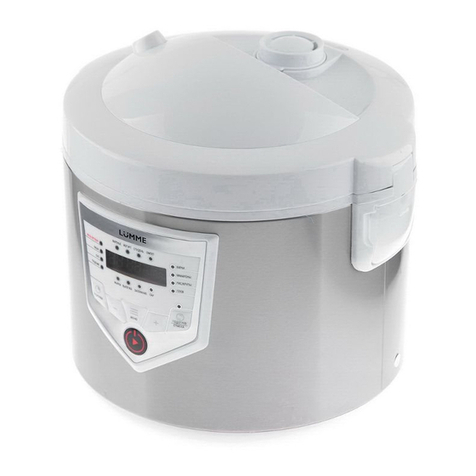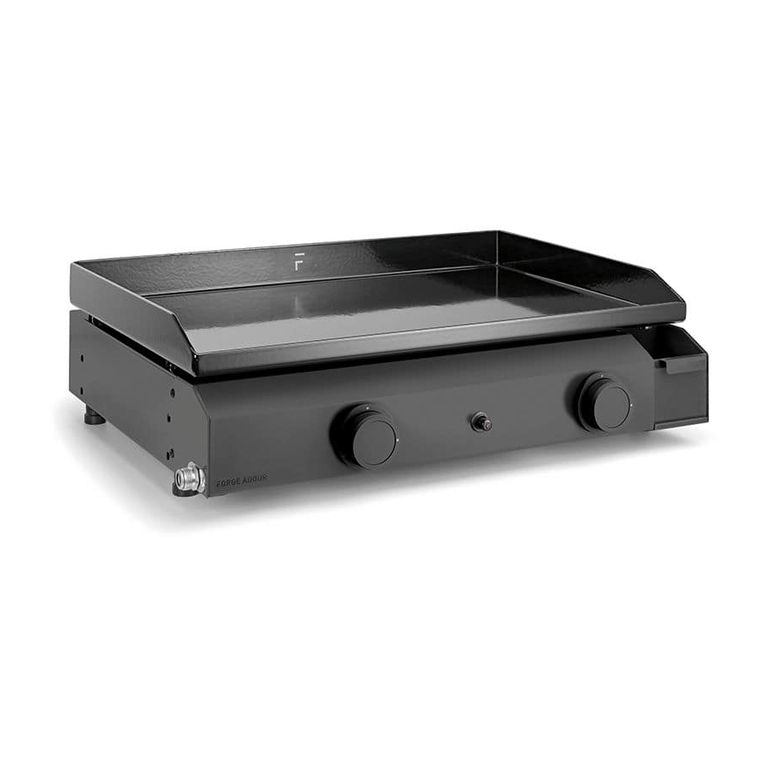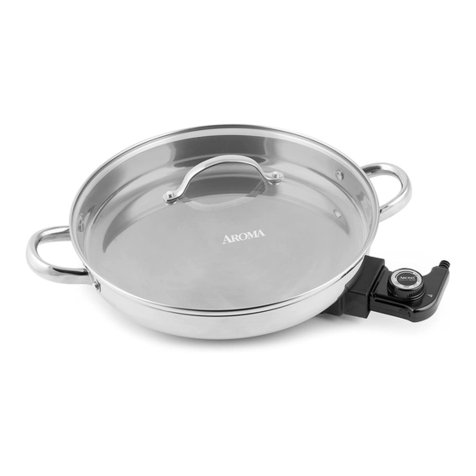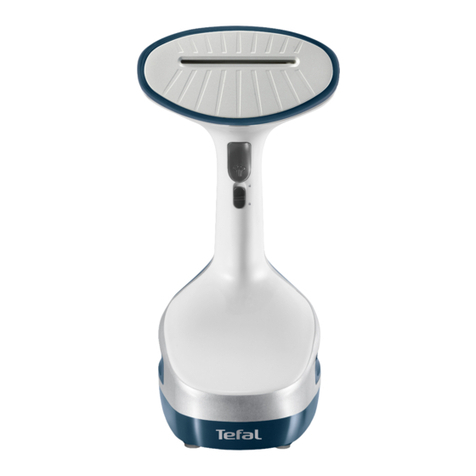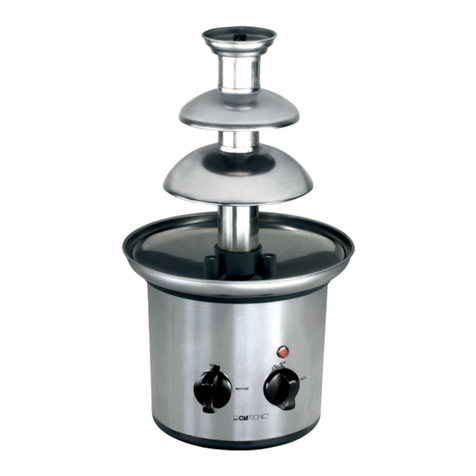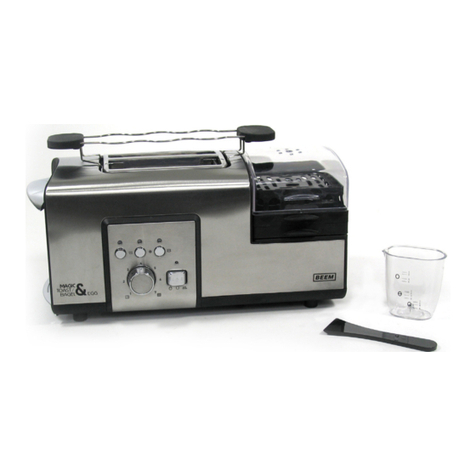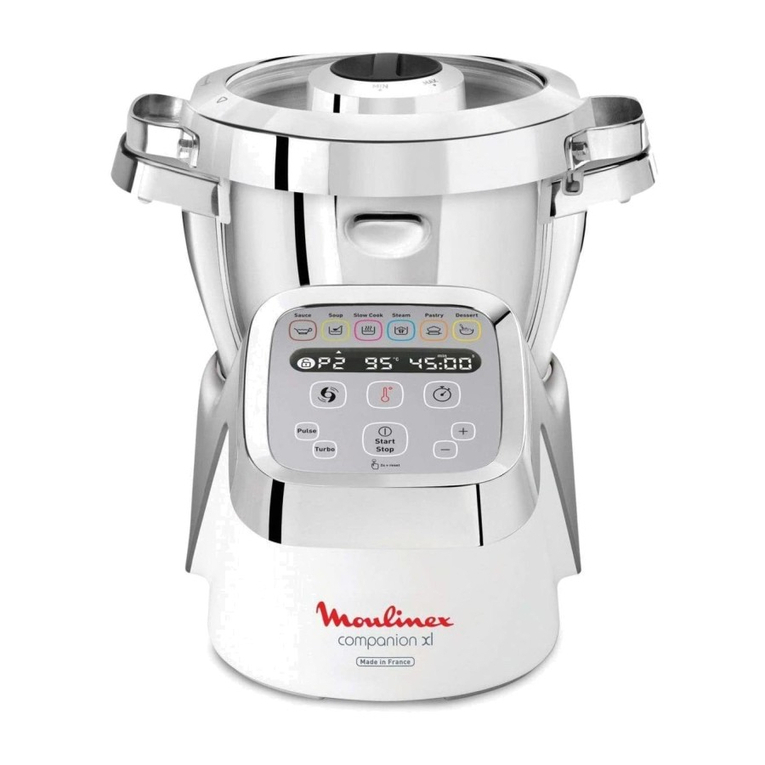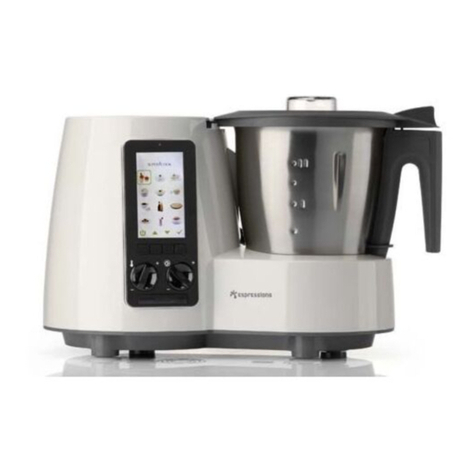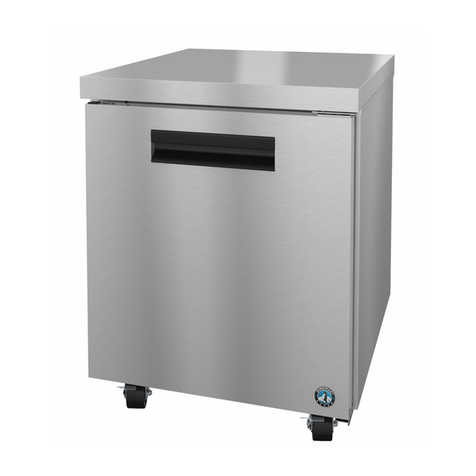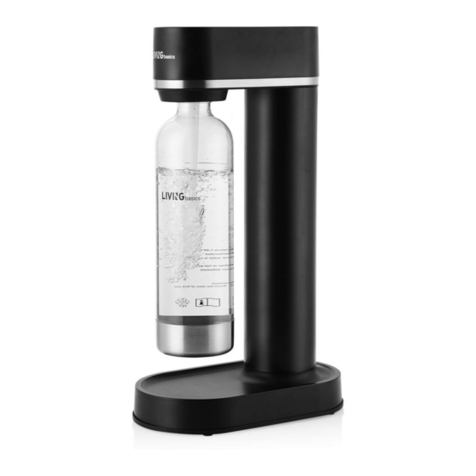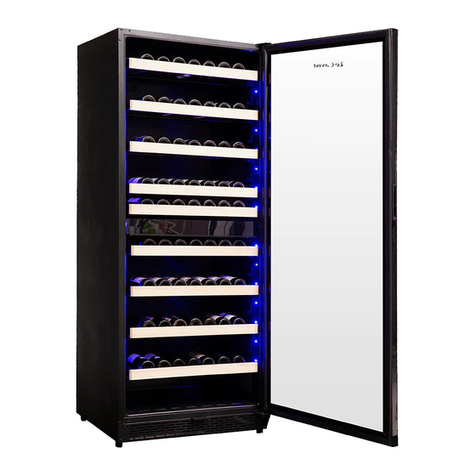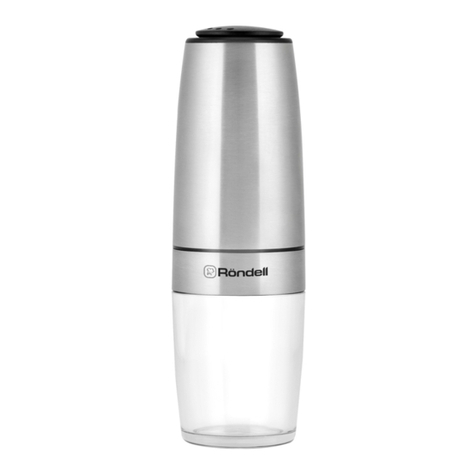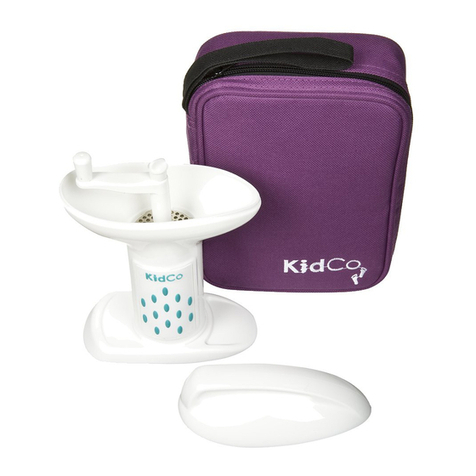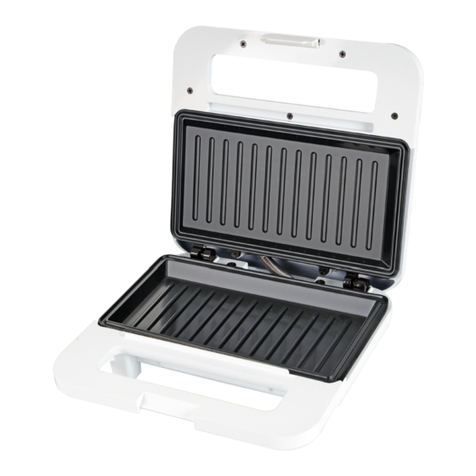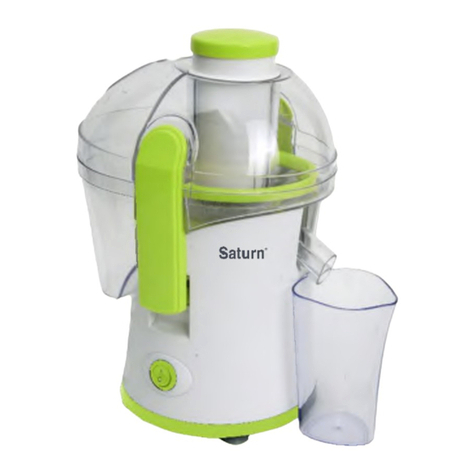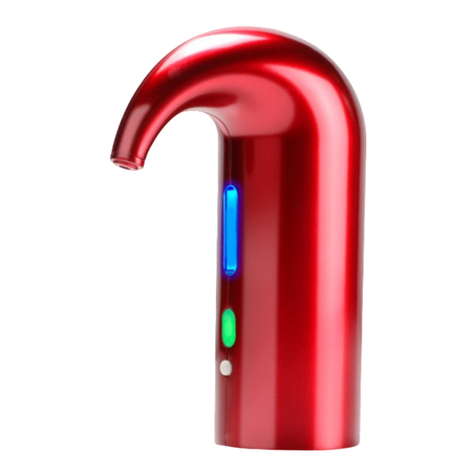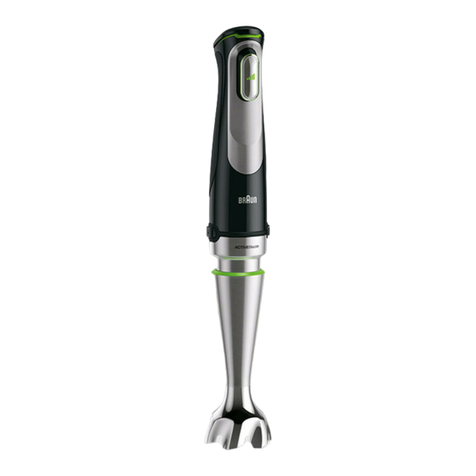Henkelman Jumbo User manual

Vacuum Packaging Machine
Jumbo
User Manual
Art No. 0894605
Original Instructions for Use
©Henkelman 2016

• The machine is not suitable for the packaging of toxic, corrosive, irritant or potentially
explosive materials.
• All persons responsible for the operation of this machine must at least fully read and
understand the chapters about the operation and safety provided in these operating
instructions.
• All persons responsible for the assembly, installation, maintenance and/or repairs must
fully read and understand these operating instructions.
• The user is at all times responsible for the interpretation and use of this manual.
Contact the owner or the manager in case of questions or doubts about the correct
interpretation.
• This manual should be kept near the machine and should be within reach for its users.
• All major maintenance work, modifications to the machine and observations must be
kept in a logbook; see Logbook on page 37.
• Modifications to the installation/machine are not allowed without the prior written
consent of the supplier.
• For specific maintenance work not included in this manual, please contact the supplier.
• Comply with the safety requirements as set out in Safety on page 7 at all times.
• The correct operation and safety of the system can only be guaranteed if the
recommended maintenance is performed on time and properly.
• Illustrations shown may differ from your machine.
Copyright ©Henkelman BV 2016
Henkelman BV reserves the right to change specifications and/or spare parts without prior notice.
The content of this user manual may also be changed without prior notice.
For information about settings, maintenance and repairs not provided for in this user manual, please contact the technical department of your supplier.
Henkelman BV accepts no liability for damage and/or problems arising from the use of spare parts not supplied by Henkelman BV.
This user manual has been compiled with all possible care. Henkelman BV assumes no responsibility for any errors in this manual and/or the
consequences of an erroneous interpretation of the instructions.
All rights reserved. No part of this publication may be reproduced, stored in computerised databases, or made public, in any form or by any means,
either electronic, mechanical, through photocopying, recording or otherwise, without the prior written consent of Henkelman BV. This also applies to the
associated drawings and diagrams.

Contents 3
Contents
List of Figures................................................................................................................................. 5
1 Preamble....................................................................................................................................... 6
2 Safety.............................................................................................................................................7
2.1 List of the Symbols Used in this Manual............................................................................... 7
2.2 Pictograms on the Machine................................................................................................... 7
2.3 General Warnings.................................................................................................................. 8
2.4 Warnings During Use.............................................................................................................9
2.5 Warnings for Operating Personnel.........................................................................................9
3 Introduction.................................................................................................................................10
4 Description of the Machine.......................................................................................................11
4.1 Overview of the Main Components......................................................................................11
4.2 Description of the Packaging Process/Machine Functions.................................................. 12
4.2.1 Packaging Process/Machine Functions........................................................................12
4.2.2 General Functions........................................................................................................ 13
4.3 Sealing System.................................................................................................................... 13
4.4 Vacuum Pump......................................................................................................................14
4.5 Electrical Installation.............................................................................................................15
5 Installation...................................................................................................................................17
5.1 Transportation and Installation............................................................................................. 17
5.2 Connecting the Machine...................................................................................................... 17
5.3 Prior to the First Use........................................................................................................... 17
6 Operation.....................................................................................................................................18
6.1 Operating Elements of the 1-Program Control.....................................................................18
6.2 Starting the Machine............................................................................................................19
6.3 Starting the Packaging Cycle...............................................................................................19
6.4 Proceeding to the Next Step in the Cycle........................................................................... 19
6.5 Terminating a Program.........................................................................................................20
6.6 Changing the Program Settings...........................................................................................20
6.6.1 1-Program Control System...........................................................................................20
6.6.1.1 Vacuum.................................................................................................................20
6.6.1.2 Seal.......................................................................................................................20
6.6.1.3 External Vacuum (optional).................................................................................. 20
6.7 Guideline for Function Values.............................................................................................. 21
7 Maintenance................................................................................................................................23
7.1 Maintenance Schedule.........................................................................................................23
7.2 Cleaning the Machine.......................................................................................................... 24
7.3 Running the Pump Cleaning Program.................................................................................24

Contents 4
7.4 Removing Oil, Refilling Oil................................................................................................... 24
7.5 Replacing the Oil Exhaust Filter.......................................................................................... 25
7.5.1 Pump 3-4 m3................................................................................................................25
7.5.2 Pump 8 m3................................................................................................................... 26
7.5.3 Pump 16 m3................................................................................................................. 27
7.6 Replacing the Sealing Wire................................................................................................. 27
7.7 Replacing the Silicone Rubber of the Silicone Holders....................................................... 29
7.8 Replacing the Lid Gasket.....................................................................................................30
7.9 Inspecting the Lid Springs................................................................................................... 30
8 Troubleshooting......................................................................................................................... 31
9 Terms of Warranty.....................................................................................................................33
9.1 Liability..................................................................................................................................33
10 Disposal.....................................................................................................................................34
11 Appendices............................................................................................................................... 35
11.1 Technical Data....................................................................................................................35
11.1.1 Technical Data Jumbo................................................................................................35
11.2 Logbook..............................................................................................................................37
11.3 EC Declaration of Conformity............................................................................................ 39

List of Figures 5
List of Figures
Figure 1: Overview of the Main Components................................................................................. 11
Figure 2: Overview of the Sealing System..................................................................................... 13
Figure 3: Overview of the Pump (Pump 3-4 m3)............................................................................14
Figure 4: Overview of the Pump (Pump 8 m3)...............................................................................14
Figure 5: Overview of the Pump (Pump 16 m3).............................................................................15
Figure 6: Overview of the Electrical Installation..............................................................................16
Figure 7: Control Panel of the 1-Program Control..........................................................................18
Figure 8: External Vacuum Adapter Set (1-Program Control)........................................................ 21
Figure 9: Vapour Pressure Curve of Water.................................................................................... 22
Figure 10: Replacing the Oil Exhaust Filter (Pump 3-4 m3)...........................................................25
Figure 11: Replacing the Oil Exhaust Filter (Pump 8 m3)..............................................................26
Figure 12: Replacing the Oil Exhaust Filter (Pump 16 m3)............................................................27
Figure 13: Removing the Sealing Bar.............................................................................................28
Figure 14: Replacing the Sealing Wire...........................................................................................28
Figure 15: Replacing the Silicone Rubber of the Silicone Holders................................................. 29
Figure 16: Replacing the Lid Gasket.............................................................................................. 30

Preamble 6
1 Preamble
This is the manual for your Henkelman vacuum packaging machine. This manual is intended for
anyone who works with or services the machine.
This manual contains information and instructions for installation, operation and maintenance
of the machine. We recommend that you carefully read this manual before use and follow the
procedures and instructions strictly. This will ensure that you get the best out of the machine and
prevents possible accidents and serious injury.

Safety 7
2 Safety
Your vacuum packaging machine has been carefully designed and expertly built to be operated
safely. This is corroborated by the EC Declaration of Conformity. However, there are always
dangers and safety risks that cannot be eliminated. These dangers and risks are the result of the
use functions of the machine and operation of the machine by the user. This section discusses
safety instructions and precautions, how they will be pointed out to you and the requirements
the user must meet. It is essential that you are well aware of these safety instructions and
requirements and observe them at all times!
2.1 List of the Symbols Used in this Manual
For all operations in which the safety of the operator and/or technician is at stake and where
caution should be exercised, the following symbols are used.
This symbol provides insight or offers tips to help facilitate certain actions.
This symbol warns for dangerous situations that may lead to damage to the machine or
personal injury.
This symbol warns for high voltage.
2.2 Pictograms on the Machine
Pictograms and warnings have been fitted on the machine to warn users of the possible risks.
Warning sign "High Voltage"
• Is located on the back of the machine
Warning sign "Heat"
• Is located on the sealing bars and on the vacuum pump

Safety 8
Machine plate
• Is located on the back of the machine
Regularly check whether the pictograms and markings are still clearly recognisable and
legible. Replace them if this is not the case.
2.3 General Warnings
• All persons responsible for the operation of this machine must at least fully read and
understand the chapters Safety on page 7 and Operation on page 18.
• Failure to follow or disregard of the safety instructions may result in serious injury.
• Never pack products that can be damaged by vacuum.
• Never vacuum live animals.
• Warranty and/or liability is void if any damage is caused by repairs and/or modifications
that are not authorised by the supplier or any of its distributors.
• In case of malfunction, contact the supplier.
• High pressure cleaning is not allowed. This may cause damage to the electronics and
other components.
• Prevent water from entering the ventilation inlet of the chamber or the exhaust of the
pump. This causes irreversible damage to the pump.
• The work space around the machine must be safe. The owner of the machine must take
the necessary precautions to operate the machine safely.
• It is forbidden to start the machine in an explosive environment.
• The machine has been designed in such a way that production is safe under normal
ambient conditions.
• The owner of the machine must ensure that the instructions in this manual are actually
complied with.
• The available safety devices may not be removed.
• The correct operation and safety of the system can only be guaranteed if the
recommended maintenance is performed on time and properly.
• If work must be carried out on the machine, it must be disconnected and blocked from
the power supply.
• Only a technical expert may perform work on the electrical installation.
• Internal procedures and monitoring must be in place to ensure that all relevant power
supplies are disconnected.

Safety 9
• The machine may not be used during cleaning, inspection, repair or maintenance and
must be disconnected from the power supply by disconnecting the plug.
• Never perform welding work on the machine without first disconnecting the cable
connection to the electrical components.
• Never use the power supply of the control unit to connect other machines.
• All electrical connections must be connected to the terminal strips according to the
wiring diagram.
2.4 Warnings During Use
• Before starting the machine, make sure no work is being performed on the installation
and that the machine is ready for use.
• The machine may not be operated by unauthorised persons. This should be monitored
by the machine operator(s).
• Immediately contact the service technician of your technical department or dealer if
something does not seem right, such as unusual vibrations or unusual noise.
• Components of the sealing system can become very hot. Contact with these
components may cause injuries.
2.5 Warnings for Operating Personnel
• Operating personnel must be 18 years or older.
• Only authorised persons are allowed to perform work on or with the machine.
• Personnel may only perform work for which it was trained. This applies to both
maintenance and normal use.
• The machine may only be operated by trained personnel.
• Operating personnel must be familiar with all circumstances, so quick and effective
action can be taken in case of an emergency.
• If an operator notices errors or risks or disagrees with safety measures, he or she
should report this to the owner or manager.
• Safety shoes are mandatory.
• Appropriate work clothing is mandatory.
• All personnel must obey the safety regulations to avoid danger to themselves and
others. Always strictly follow the work instructions.

Introduction 10
3 Introduction
Henkelman BV is a supplier of ultra-modern vacuum packaging machines. Our machines are
developed and manufactured to meet the highest standards. They combine a sleekly built and
functional design with optimal ease of use and a long service life. After mounting the plug, it is just
a matter of "plug & pack". The clever design ensures compliance with the hygiene standards at all
times.
The Jumbo series are professional table top models, use-friendly and low-maintenance.

Description of the Machine 11
4 Description of the Machine
This section provides an overview of the main components and functions. If detailed information is
available in this manual, you will be referred to the specific sections.
4.1 Overview of the Main Components
The figure below shows the main components of the system. The model shown may differ from
your machine.
Figure 1: Overview of the Main Components
1. Lid
The lid closes the vacuum chamber during the application of the vacuum. A rubber is mounted
in the lid to ensure proper closing. Silicone holders are mounted in the lid as counter beams of
the sealing bar(s).
2. Vacuum chamber
The products to be packaged are placed on the work surface with the openings of the vacuum
bags on the sealing position.
3. Seal system
Depending on the model, one or two sealing bars are mounted in the vacuum chamber. These
close the vacuum bag.
4. Control panel
This serves to operate the available control functions.
5. Machine housing
The machine housing contains all the components necessary for the functioning of the
machine.

Description of the Machine 12
6. Vacuum pump
The vacuum pump creates the vacuum.
7. Power connection and cable
This serves to connect the machine to the power supply.
4.2 Description of the Packaging Process/Machine Functions
This section provides an overview of the packaging process and available machine functions.
See Changing the Program Settings on page 20 for information about setting the
parameters to the correct values.
4.2.1 Packaging Process/Machine Functions
This section describes the packaging process and the machine functions. See Operation on page
18 for the realization of the specific steps of the procedure.
Step Process phase Operation
1. Preparation The operator puts the product in a vacuum bag and places it
on the work surface with the opening on the sealing position.
2. Applying vacuum The vacuum process is initiated by closing the lid.
During the cycle, the air will be removed from the chamber
until the set time has been reached.
3. Sealing The sealing bars are pressed against the vacuum bag and
melt the bag closed.
During the sealing process, the material of the vacuum bag
is heated and pressed together to create a hermetic seal.
The programming of this function takes place in seconds.
Optionally, the second sealing wire can be replaced by a
cut-off wire. The purpose of the cut-off wire is to remove the
excess foil from the remaining flap.
4. Decompressing The vacuum is removed from the vacuum chamber by letting
air into the chamber.
5. Opening the
vacuum chamber The lid opens.
6. Removing the
product The operator can remove the packaged product from the
work surface.

Description of the Machine 13
4.2.2 General Functions
Function Pictogram Operation
Cleaning of the
oil pump
The pump cleaning program ensures that the pump is thoroughly
rinsed. During the program, the pump and oil reach the
operating temperature, so the oil and moisture are separated
and any contamination is filtered. The high temperature causes
any moisture in the pump to evaporate, thus minimising the risk
of corrosion.
External
Vacuum This function allows special food containers to be vacuumed
outside the machine.
The options to set the vacuum value are the same as for
standard vacuuming (see External Vacuum (optional) on page
20).
4.3 Sealing System
The sealing system closes the opening(s) of the bag to retain the vacuum and/or gas in the bag.
The end of the bag can optionally be cut off by the sealing bar.
Figure 2: Overview of the Sealing System
1. Sealing bar
The sealing bar consists of the following components:
• Sealing wires: during the sealing process, the sealing wires are heated for a certain time
causing the edges of the vacuum bag to melt together.
• Cut-off wires (optional): A cut-off wire is heated in such a way that the foil of the bag
partially melts, allowing the excess foil of the vacuum bag to be removed easily.
• Teflon tape: sealing and cut-off wires are covered with Teflon tape to prevent the bag from
sticking to the sealing bar.

Description of the Machine 14
Consult Replacing the Sealing Wire on page 27 for more detailed information about
maintenance.
2. Silicone holder
Opposite the sealing bar is a silicone holder which provides counterpressure on the cylinders
(Replacing the Silicone Rubber of the Silicone Holders on page 29).
3. Sealing mechanism
The sealing bars are pressed onto the vacuum bag by cylinders.
By connecting the inlet of the cylinders with the atmospheric pressure outside, they press the
sealing bar onto the bag.
4.4 Vacuum Pump
The vacuum pump creates the vacuum.
Figure 3: Overview of the Pump (Pump 3-4 m3)
Figure 4: Overview of the Pump (Pump 8 m3)

Description of the Machine 15
Figure 5: Overview of the Pump (Pump 16 m3)
1. Vacuum pump - Creates the vacuum for the process.
2. Oil exhaust filter - Filters the air by capturing oil vapours.
3. Oil sight glass - Indicates the maximum and minimum oil levels of the vacuum pump.
4. Oil drain plug - Removing the oil drain plug allows the oil to be drained.
5. Oil filler plug - Removing the oil filler plug allows the oil to be refilled.
4.5 Electrical Installation
The electrical installation provides power for the vacuum pump, the seal system and the operation
of the machine.
See the electrical diagram for the further structure and operation of the electrical installation.
Please contact your supplier for the electrical diagram.
Only a technical expert may perform work on the electrical installation.

Description of the Machine 16
The machine consists of the following electrical components:
Figure 6: Overview of the Electrical Installation
1. Power connection and cable
This serves to connect the machine to the power supply.
2. Control panel
This serves to operate the control functions. Your machine has the following control option:
•Operating Elements of the 1-Program Control on page 18

Installation 17
5 Installation
Consult Technical Data on page 35 for the specifications of the machine.
Before installing the machine, carefully read the safety instructions in Safety on page 7.
Failure to follow or disregard of the safety instructions may result in serious injury.
5.1 Transportation and Installation
The machine must be moved and transported in an upright position.
1. Place the machine on a flat, level surface. This is essential to ensure a trouble-free operation
of the machine.
Do not position machines with plastic covers in the vicinity of a heat source.
Make sure there is sufficient space (at least 15 cm) around the machine to ensure a
proper ventilation.
2. Verify that the machine housing is present and correctly fitted.
5.2 Connecting the Machine
1. Make sure the voltage stated on the machine plate matches the mains voltage.
2. Connect the machine to a grounded wall outlet to avoid fire or electric shock.
The power cable must be free at all times, and nothing may be placed on it.
Immediately replace the power cable if damaged.
5.3 Prior to the First Use
1. Check the oil sight glass to see if the amount of oil in the pump is sufficient.
2. Optional: If the amount of oil in the pump is insufficient, refill it. See Removing Oil, Refilling Oil
on page 24.
3. Proceed with Starting the Machine on page 19 to start up the machine.
4. Run the pump cleaning program before using the machine for the first time (see Running the
Pump Cleaning Program on page 24).

Operation 18
6 Operation
It is possible to optimise a program for your products by modifying the parameters of a program,
see Changing the Program Settings on page 20.
• All persons responsible for the operation of this machine must at least fully read and
understand the chapters Safety on page 7 and Operation on page 18.
• Failure to follow or disregard of the safety instructions may result in serious injury.
6.1 Operating Elements of the 1-Program Control
The 1-program control allows the machine to be operated and programs to be changed.
See Operation on page 18 for instructions on the operation and programming.
Figure 7: Control Panel of the 1-Program Control
1. On/Off button
Serves to turn the control panel on or off.
Depending on the model, the on/off button is located on the left side of the control panel (as
shown in Figure 7: Control Panel of the 1-Program Control on page 18) or on the rear of
the machine near the power cord.
2. Cursor key
This key is used to operate the functions of the parameter display and function display.
3. Pump cleaning program button
This is used to activate the pump cleaning program. Moisture can condensate in the oil
when the pump is running only short cycles or when you are packaging moisture-containing
products. This program removes moisture from the oil of the vacuum pump. See Running the
Pump Cleaning Program on page 24 for instructions.
4. Parameter display
This display shows the current value of the active function during the program cycle or the set
value of the selected function when the machine is inactive.

Operation 19
5. Function display
The LED light in front of the function lights up if the function is active during the program cycle
or if the function is selected in the programming mode.
6. – / STOP button
This is used to interrupt the entire cycle during a packaging cycle. All functions are skipped
and the cycle is terminated. In the programming mode, the value of the selected parameter
can be lowered using this button.
7. + / VACUUM STOP button
This stops the active function and proceeds to the next program step. In the programming
mode, the value of the selected parameter can be increased using this button.
8. Vacuum meter
Shows the pressure in the vacuum chamber. A value of -1 bar corresponds to 99% vacuum.
6.2 Starting the Machine
1. Plug in the machine.
2. Press the on/off button on the control panel to enable the operation.
2 dashes may be shown on the display during the first start-up or ventilation. This means that the
machine needs to be decompressed. In this case, open the lid to decompress the machine.
6.3 Starting the Packaging Cycle
The machine must be started in accordance with Starting the Machine on page 19 before
starting a packaging cycle.
1. Put the product/products in place.
a. Put the product/products in the vacuum bag.
b. Place the vacuum bag in/on the vacuum chamber. Make sure the opening(s) is/are
correctly placed with regard to the seal position(s).
2. Close the lid.
The packaging cycle will start.
6.4 Proceeding to the Next Step in the Cycle
For some products, it may be necessary to proceed to the next step in the packaging cycle before
the vacuum time or the vacuum level has been reached.
1. Proceed to the next step in the cycle.
Press the + / VACUUM STOP button.
The next step will be started.

Operation 20
6.5 Terminating a Program
Programs such as the packaging program or the pump cleaning program can be terminated at any
time.
1. Terminate the program.
Press the – / STOP button.
The program will be terminated and the vacuum chamber is decompressed.
6.6 Changing the Program Settings
6.6.1 1-Program Control System
This section describes the units and limits of the parameters and how parameters can be adjusted.
See Operating Elements of the 1-Program Control on page 18 for an overview of the operating
elements of the 1-program control system.
1. Use the Cursor key to scroll to the desired parameter.
The LED in front of the selected function will light up.
2. Press the – / STOP button and the + / VACUUM STOP button to adjust the value.
The – / STOP button and the + / VACUUM STOP button must be pressed and held for several
seconds to adjust the value. This prevents the accidental changing of settings.
3. Press the Cursor key to activate the new parameter.
6.6.1.1 Vacuum
During the cycle, the air is removed from the chamber until the set time has been reached.
1. Use the Cursor key to scroll to the parameter Vacuum.
The LED in front of the selected function will light up.
2. Press the + / VACUUM STOP button to adjust the value.
The – / STOP button and the + / VACUUM STOP button must be pressed and held for several
seconds to adjust the value. This prevents the accidental changing of settings.
3. Press the Cursor key to activate the new parameter.
6.6.1.2 Seal
This is the time that the sealing wire and/or the cut-off wire are heated. The longer the time, the
more heat is transferred to the bag.
1. Use the Cursor key to scroll to the parameter Seal.
The LED in front of the selected function will light up.
2. Press the – / STOP button and the + / VACUUM STOP button to adjust the value.
The – / STOP button and the + / VACUUM STOP button must be pressed and held for several
seconds to adjust the value. This prevents the accidental changing of settings.
3. Press the Cursor key to activate the new parameter.
6.6.1.3 External Vacuum (optional)
The External Vacuum function allows special food containers to be vacuumed outside the machine.
Other manuals for Jumbo
1
Table of contents
Other Henkelman Kitchen Appliance manuals
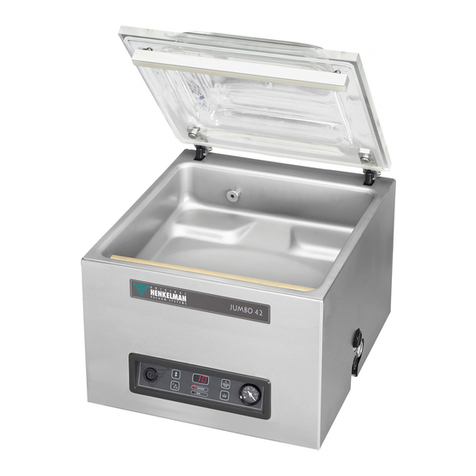
Henkelman
Henkelman Jumbo series User manual
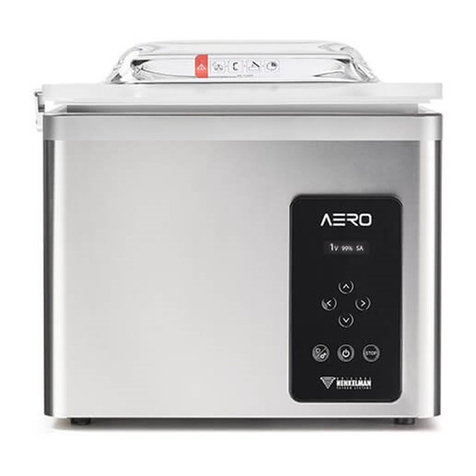
Henkelman
Henkelman Aero User manual
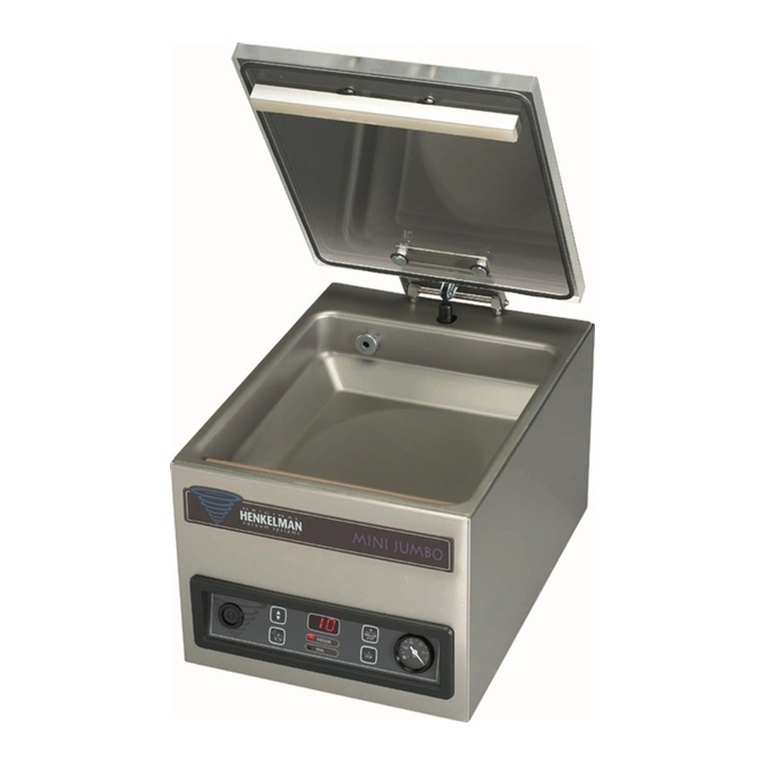
Henkelman
Henkelman Mini Jumbo User manual
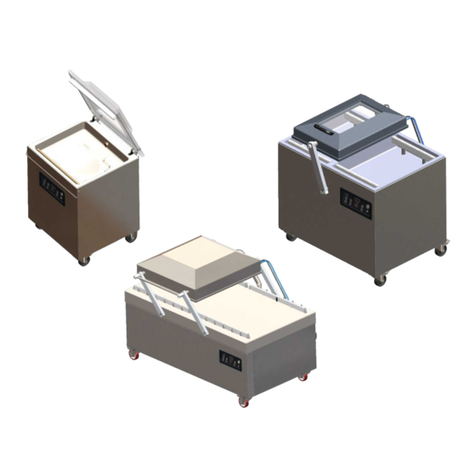
Henkelman
Henkelman Marlin User manual
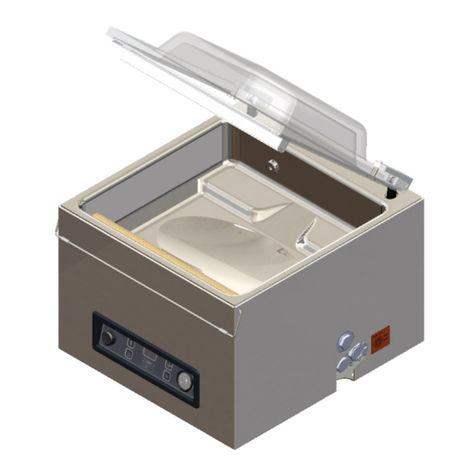
Henkelman
Henkelman Jumbo Installation and operation manual

Henkelman
Henkelman DT 60 User manual
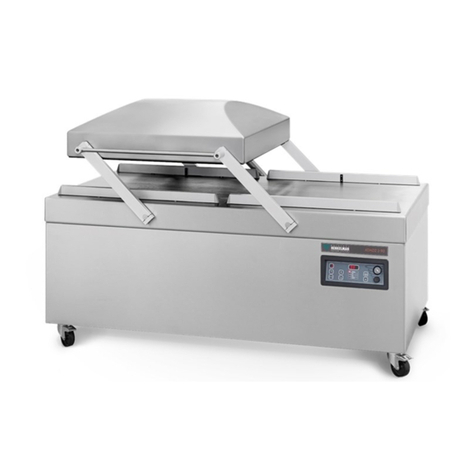
Henkelman
Henkelman Atmoz Series User manual
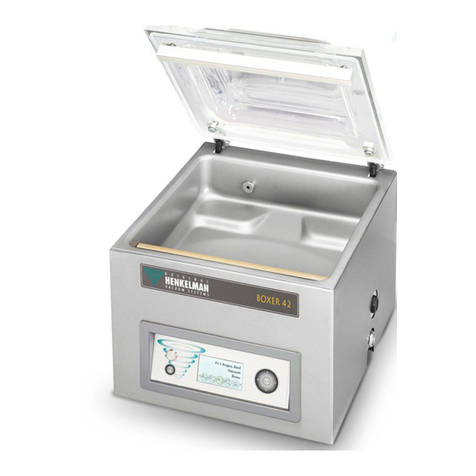
Henkelman
Henkelman Boxer Series User manual
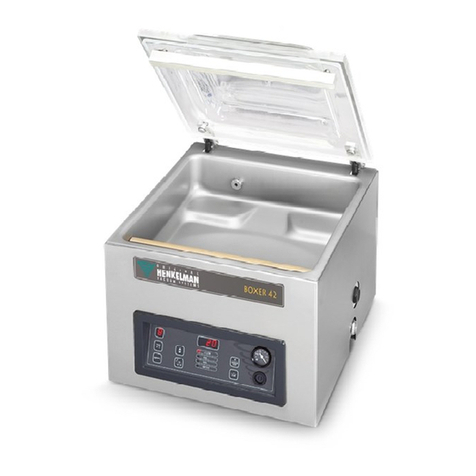
Henkelman
Henkelman Boxer 35 User manual
